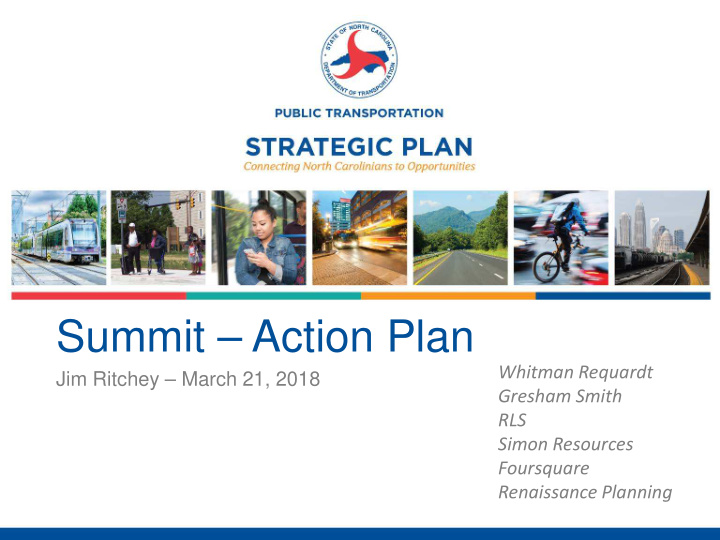



Summit – Action Plan Whitman Requardt Jim Ritchey – March 21, 2018 Gresham Smith RLS Simon Resources Foursquare Renaissance Planning
Summit March 21, 2018 Fastest Ridership Growth in the Southeast Percent Ridership Growth Since 1995 Tennessee 140.00% 115% 120.00% Georgia 100.00% South Carolina 80.00% 67% Florida 60.00% 50% 40.00% Virginia 20.00% 12% North Carolina 2% 0.05% 0.00%
What We Heard Public Transportation Vision & Challenges Your Vision for Public Transportation in North Carolina Category # Responses Examples Extent of transit system 37 No-borders, Ubiquitous, Regional, Rural, Growing Service characteristic 37 Frequent, Multi-modal, Fast, Innovative Connected / Opportunity 28 Connected, Seamless, Coordinated, Options Customer experience 28 Easy, Convenient, Useful, Liberating Accessible / Inclusive 23 Accessible, Inclusive, Critical, Lifeline System characteristic 21 Effective, Efficient, Successful Service specific 18 Light Rail, High-Speed Rail, Commuter Rail, Greenways Fares and affordability 9 Affordable, Single pay, Free Total responses 206 Greatest Challenge Facing Public Transportation in North Carolina Local funding 34% State funding 20% Political boundaries 17% Interagency cooperation 10% Federal funding 9% Buses and facilities (capital) 6% Compliance with federal regulations 2% Percent of Responses Management capacity 1% 0% 5% 10% 15% 20% 25% 30% 35% 40%
What We Heard Travel Market Analysis Travel Market Observations Weekday Commuter Flows Central Wake County • Travel patterns are regional for work, education and services • Longer distance commuting markets exist in many regions • Access to healthcare and community colleges requires longer distance trips • Service area boundaries create barriers to opportunities
What We Heard Statewide Mobility & Access to Opportunity
Need for Transit Why is Transit Needed? • Aging Population • Low Income Population • Households without Access to an Automobile • Persons with a Disability • North Carolinians without a Driver’s License • Increasing Traffic Congestion and Longer Commuting Distances • Central City Population Growth • Support Economic Development through Access to Jobs and Workforce Development
Need for Transit
Need for Transit Population Change by Age Group 2016 to 2036 • By 2036, North Carolina’s population of persons older than age 65 will grow by a million persons or 64.5 percent. North Carolina Population by Age Group 2016 to 2036 in millions Age Group 2016 2026 2036 % Change < 18 2.3 2.4 2.6 +10.5% 18 - 24 1.0 1.1 1.1 +8.2% 24 - 64 5.3 5.6 6.1 +14.8% 64+ 1.6 2.1 2.6 +64.5% Source: NC Office of Management and Budget, 2017 https://www.osbm.nc.gov/demog/countytotals_standardagegroups 8
Need for Transit
Summit March 21, 2018 Strategic Plan Elements Vision Mission Strategies Tactics Actions
Summit March 21, 2018 Vision Connecting North Carolinians to Opportunities Mission Improve North Carolinian’s quality of life by: • Building healthy communities • Supporting job creation and economic development • Providing equal opportunities so all people can thrive
Summit March 21, 2018 Strategy #1 - Building Thriving, Healthy Communities Partner for a Successful Future Tactics a.Partner with local organizations, community colleges, state agencies, business community and customers to focus transit services so people thrive b.Provide enhanced access for seniors, veterans and persons with disabilities c.Build quality transit stops and safe pedestrian crossings d.Support transit-friendly land use
Summit March 21, 2018 NC Population 65 and Over vs State Local Transit Program* 2,500,000 $144,000,000 $124,000,000 2,000,000 $104,000,000 Population over 65 years Transit Program Funding 1,500,000 $84,000,000 $64,000,000 1,000,000 $44,000,000 500,000 $24,000,000 0 $4,000,000 1990 1991 1992 1993 1994 1995 1996 1997 1998 1999 2000 2001 2002 2003 2004 2005 2006 2007 2008 2009 2010 2011 2012 2013 2014 2015 2016 2017 2018 2019 2020 2021 2022 2023 2024 2025 2026 2027 2028 2029 2030 2031 2032 2033 2034 2035 2036 2037 Fiscal Year *State Local Transit Program spending does not include the Blue Line $25m per year or the special event funding
Summit March 21, 2018 Strategy #2 - Improving Access to Jobs and Economic Development Support Local Transit Systems Tactics a. Provide enhanced local services in response to changing demographics b. Establish regional multi-county commuter services c. Enable new local services d. Engage the business community in strengthening job creation and economic development e. Push planning beyond local boundaries f. Utilize employer-based carpooling, vanpooling and telework programs to provide regional transportation choices
Need for Transit
Summit March 21, 2018 Commerce Prosperity Zones
Summit March 21, 2018 Strategy #3 - Connecting Communities to Opportunities Build A Connected Statewide Network Tactics a.Build The Connected Statewide Network b.Utilize technology to foster transit system integration, innovation and operating efficiency c.Extend the public transportation network’s reach d.Improve transit travel times through implementing operating innovations e.Support and enable greater flexibility in funding transit investments
Summit March 21, 2018 Grow existing out-of-county services into statewide network
Summit March 21, 2018 Reports and Deliverables • Strategic Plan Brochure • Summarizes the vision, need for transit and strategies • Executive Report • Action oriented and engaging to communicate the Plan’s recommendations • Strategic Plan • Resource document that provides detailed information and planning process records
Contact Us: Debbie Collins, Director Jim Ritchey Public Transportation Division WRA dgcollins1@ncdot.gov jritchey@wrallp.com (919) 707.4684 (404) 433.1379 https://www.ncdot.gov/nctransit/strategicplan
Recommend
More recommend